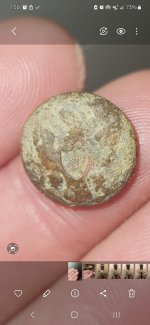Neanderthal
Bronze Member
As many of you know, I posted a red lanceolate point a while back on here and asked the question "what is it?". I will again post a picture of it below, to refresh your memory.

Believe it or not ladies & germs, this is a Calf Creek piece. It was found in direct association with other Calf Creek Complex items in Northwest Arkansas. In fact, the entire site it was found on comprises pretty much solely of Calf Creek cultural items - including Cossattot River. Would you have associated it with Calf Creek? No, but don't feel bad...nobody did except for one person. Kevin young found a similar specimen last year, same manufacturing traits. I assume the knapper broke at least one of the ears off during manufacture and decided it was still useful to him without them. If you look very closely at the lanceolate, you will see where the flaking dramatically changes (well below where the coloration changes in the material). This was the original "stem" area. Below is a picture of Kevin Young's similar lanceoloate, found in Northeast Oklahoma.

I made this post to show that things aren't always as they appear. Do not judge a point by it's outline. The majority of artifacts we found have been used and resharpened to exhaustion or near it. These points often lose their identifying traits during this process, and it becomes very hard to accurately "type" them. Below is a picture of some of the artifacts found with the Calf Creek Lanceolate. Sorry it took so long to respond!

Matt

Believe it or not ladies & germs, this is a Calf Creek piece. It was found in direct association with other Calf Creek Complex items in Northwest Arkansas. In fact, the entire site it was found on comprises pretty much solely of Calf Creek cultural items - including Cossattot River. Would you have associated it with Calf Creek? No, but don't feel bad...nobody did except for one person. Kevin young found a similar specimen last year, same manufacturing traits. I assume the knapper broke at least one of the ears off during manufacture and decided it was still useful to him without them. If you look very closely at the lanceolate, you will see where the flaking dramatically changes (well below where the coloration changes in the material). This was the original "stem" area. Below is a picture of Kevin Young's similar lanceoloate, found in Northeast Oklahoma.

I made this post to show that things aren't always as they appear. Do not judge a point by it's outline. The majority of artifacts we found have been used and resharpened to exhaustion or near it. These points often lose their identifying traits during this process, and it becomes very hard to accurately "type" them. Below is a picture of some of the artifacts found with the Calf Creek Lanceolate. Sorry it took so long to respond!

Matt
Amazon Forum Fav 👍
Upvote
0





 I was starting to turn red faced again hahaha
I was starting to turn red faced again hahaha  But really....... that is a great post and even a guy like me can get the point of it. Thanks Neanderthal.
But really....... that is a great post and even a guy like me can get the point of it. Thanks Neanderthal.




